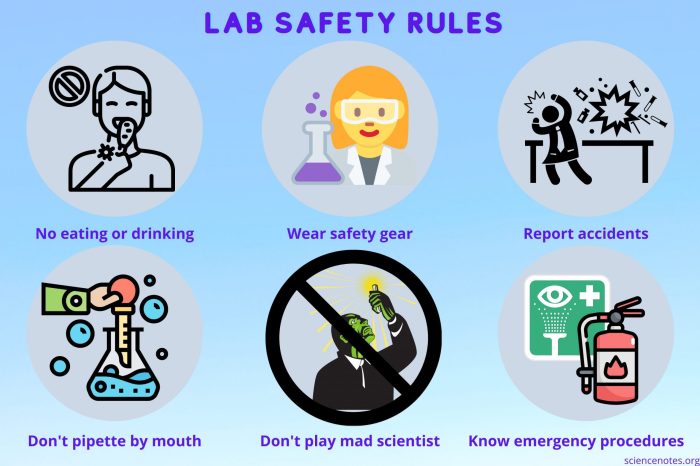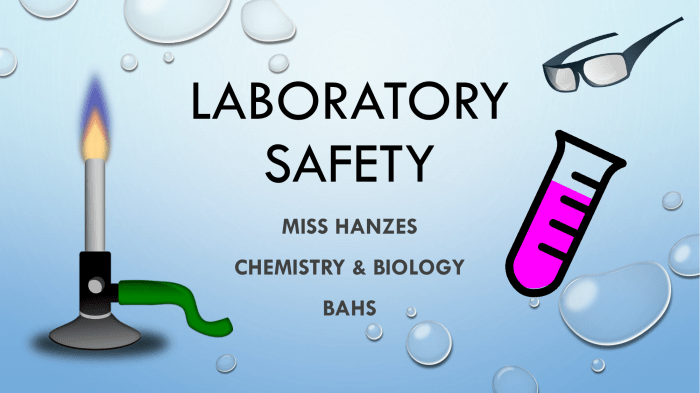Safety rules in biology laboratory – Adhering to safety rules in biology laboratories is paramount to ensure the well-being of individuals and the integrity of research. This comprehensive guide delves into the essential safety protocols, personal protective equipment (PPE), laboratory equipment handling, chemical safety, biological safety, and emergency procedures that form the cornerstone of a safe laboratory environment.
By understanding and implementing these guidelines, laboratory personnel can effectively mitigate potential hazards, minimize risks, and foster a culture of safety consciousness within the laboratory setting.
Safety Regulations and Protocols
Adhering to safety regulations in a biology laboratory is paramount to ensure the well-being of individuals and prevent potential hazards. Failure to comply can lead to accidents, injuries, or even fatalities.
Potential hazards include exposure to hazardous chemicals, biological agents, sharp objects, electrical equipment, and fires. Consequences of these hazards can range from minor skin irritations to severe burns, infections, and explosions.
Laboratory personnel have the responsibility to maintain a safe environment by following established safety protocols, wearing appropriate personal protective equipment, handling equipment safely, and adhering to chemical safety guidelines.
Personal Protective Equipment (PPE)

PPE is essential for protecting individuals from potential hazards in a biology laboratory.
- Gloves: Protect hands from chemical spills, biological agents, and sharp objects.
- Lab coats: Prevent contamination of clothing and skin from hazardous materials.
- Safety glasses: Protect eyes from chemical splashes, flying debris, and radiation.
- Respirators: Protect lungs from inhalation of hazardous fumes, gases, and dust.
Proper use and maintenance of PPE is crucial. Gloves should be changed frequently, lab coats should be laundered regularly, and safety glasses should be cleaned and inspected before each use. Respirators must be fitted and tested for proper function.
Consequences of not wearing appropriate PPE can include skin irritation, eye damage, respiratory problems, and infections.
Laboratory Equipment Safety
Common laboratory equipment includes microscopes, centrifuges, and Bunsen burners, each posing potential hazards.
- Microscopes: Eye strain, cuts from broken glass.
- Centrifuges: Explosions from improper loading, injuries from moving parts.
- Bunsen burners: Burns from open flame, fires from gas leaks.
Safe handling and operation of equipment is essential. Microscopes should be used with proper lighting and eye protection. Centrifuges should be loaded carefully and operated with the lid closed. Bunsen burners should be lit and extinguished properly, and gas leaks should be reported immediately.
Regular equipment maintenance and calibration are crucial to prevent accidents. Microscopes should be cleaned and adjusted regularly. Centrifuges should be inspected and serviced periodically. Bunsen burners should be checked for leaks and cleaned as needed.
Chemical Safety
Biology laboratories use a variety of chemicals, including acids, bases, solvents, and flammable liquids.
- Acids: Corrosive to skin and eyes, can cause burns.
- Bases: Can cause skin irritation and burns, damage eyes.
- Solvents: Flammable, can cause skin irritation and respiratory problems.
- Flammable liquids: Highly combustible, can cause fires and explosions.
Proper handling, storage, and disposal of chemicals are essential. Chemicals should be stored in appropriate containers, labeled clearly, and kept away from incompatible substances. Spills should be cleaned up immediately using appropriate spill kits.
Chemical accidents can include spills, fires, and explosions. Prevention measures include proper storage, careful handling, and immediate reporting of accidents.
Biological Safety

Biology laboratories work with biological materials, including microorganisms and human specimens, which can pose health risks.
Aseptic technique involves using sterile techniques to prevent contamination of samples and the environment. Proper sterilization and disinfection of equipment and work surfaces are crucial.
Biosafety cabinets provide a controlled environment for working with hazardous biological agents. They prevent the release of aerosols and protect users from exposure.
Emergency Procedures: Safety Rules In Biology Laboratory

Emergency procedures are essential for responding to accidents and emergencies in a biology laboratory.
- Fire: Use appropriate fire extinguisher, evacuate the area.
- Spill: Contain the spill, use appropriate spill kit, notify supervisor.
- Injury: Seek medical attention, report the incident.
Safety equipment such as fire extinguishers and eyewash stations should be easily accessible and used properly.
Reporting accidents and incidents is crucial for preventing future occurrences and improving safety measures.
Commonly Asked Questions
Why is it important to follow safety rules in a biology laboratory?
Following safety rules in a biology laboratory is crucial to protect individuals from potential hazards, such as chemical spills, biological agents, and electrical equipment. It also ensures the accuracy and reliability of research results by minimizing contamination and errors.
What are the most common hazards in a biology laboratory?
Common hazards in a biology laboratory include exposure to hazardous chemicals, biological materials, sharp objects, and electrical equipment. These hazards can cause injuries, infections, or even fatalities if not handled properly.
What are the responsibilities of laboratory personnel in maintaining a safe environment?
Laboratory personnel are responsible for adhering to safety rules, wearing appropriate PPE, handling equipment safely, and reporting any accidents or incidents. They must also be aware of the potential hazards in the laboratory and take steps to minimize risks.